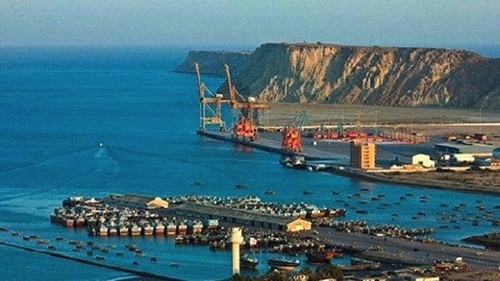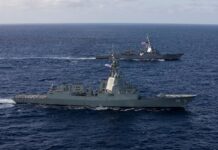 By Lindsay Hughes, Research Analyst, Indian Ocean Research Program
By Lindsay Hughes, Research Analyst, Indian Ocean Research Program
The so-called “String of Pearls” construct has been dismissed as a threat to India by Indian and other analysts alike, But China’s acquisition of Kyaukphyu Port in Myanmar after years of negotiation must now give those individuals some pause for thought.
China has, simultaneously, persuaded Thailand to revisit the idea of constructing a canal across the Isthmus of Kra that would connect the South China Sea to the Bay of Bengal.
If that were to eventuate, China would have immediate and virtually unfettered access to the Indian Ocean.
That would also complete the encirclement feared by India, giving New Delhi cause to reconsider its options and strategy.
Summary
It was reported that China and Myanmar signed an agreement on 8 November according to which China would construct a port at Kyaukphyu, a strategic city in Myanmar that lies on the Bay of Bengal coast. A Chinese consortium, led by the state-owned conglomerate, Citic Group, signed the framework agreement with the Kyaukphyu Special Economic Zone Management Committee to develop a deep-water port at the existing Kyaukphyu facility. The multi-billion dollar project had stalled for years due to financing and other issues.
According to the report, China will fund 70 per cent of the investment for the project and Myanmar, 30 per cent. The initial phase of the project will include two berths with a total investment of US$1.3 billion ($1.8 billion), according to the agreement.
A joint venture will be set up to construct and operate the port. The Chinese consortium first acquired the right to construct the port in December 2015 but that initiative was closed due to differences between the two countries regarding funding. China initially sought to invest 85 per cent of the estimated US$7 billion cost of constructing the port, which would have given it better terms in the agreement and a stronger say in the management and running of the port.
Increased scrutiny of China’s terms in the wake of Sri Lanka’s Hambantota port fiasco and Malaysia’s decision to reduce Chinese investment in some of its infrastructure projects led to the Kyaukphyu project being stalled.
Almost in sync with the developments surrounding Kyaukphyu, news was emerging that Thai Prime Minister, General Prayuth Chan-ocha, had ordered Thailand’s National Security Council to examine the feasibility of building a 120-kilometre canal across the Isthmus of Kra in the kingdom’s south. That directive was issued a month after China’s ambassador to Thailand confirmed that the canal would be an integral part of Beijing’s Belt and Road Initiative. If it were to eventuate, the canal would enable Chinese warships to slash their journeys to the Indian Ocean by around 1,200 kilometres, give China full and almost unfettered access to the Andaman Sea, complete an encirclement of India, better project its power into the Indian Ocean and, consequently, place New Delhi under considerable pressure.
 Analysis
Analysis
Some analysts have dismissed the so-called “String of Pearls” as unworkable and self-constraining, but many Indian analysts have kept a wary watch on China’s activities in the Indian Ocean for some time now. It would appear that the caution of the Indian observers was not without foundation. China currently has acquired Indian Ocean footholds in Sri Lanka, Pakistan and Djibouti. It is constrained, however, by its dependence on the Strait of Malacca, the same geographical feature that is controlled to a large extent by the United States Navy’s Seventh Fleet. That, coupled with the fact that over 80 per cent of China’s energy supplies from the Middle East and Africa pass through the Strait of Malacca, has given rise to China’s “Malacca Dilemma”. Little wonder, then, that China has long sought an alternative route for its energy imports from that part of the world.
It is in that context that China’s bid for a deep-water port at Kyaukphyu makes strategic sense for at least two reasons. First, it remains unclear whether Bangkok would actually construct a canal across the Kra Isthmus. Thailand remains relatively close to the United States. The two countries recognised each other in 1818 and established a diplomatic relationship by signing a Treaty of Amity and Commerce in 1833, a treaty that was renewed in 1966. Both countries were signatories of the 1954 Manila Pact of the former South-East Asia Treaty Organisation. Even though the organisation was dissolved in 1977, the Manila Pact remains in force and, together with the Thanat-Rusk communiqué of 1962 and the 2012 Joint Vision Statement for the Thai-US Defence Alliance, constitutes the basis of US security commitments to Thailand. In 2003, Washington designated Thailand a major non-NATO ally. It is unlikely that Bangkok would do anything that could damage that relationship.
That notwithstanding, former Second Army region commander, General Thawatchai Samutsakorn, who now serves as the Thai Canal Association’s Vice Chairman, told the Bangkok Post that the aim of his Association was ‘to demand the government set up a panel to conduct a feasibility study of the canal, which would be our first step’, adding, ‘If the canal project cannot be implemented under this government, there is no hope that it will be driven by a future elected government. When there are opposition parties involved, they are bound to oppose it without considering the benefits for the country and the people.’ He made his motivation explicit. ‘We would eventually be left standing in last place among ASEAN countries [without the Kra Canal project]’ but ‘If we make the Kra Canal, we can become an ASEAN leader.’
Second, even if Thailand were to construct a canal across the Kra Isthmus, that, by itself, would only be of partial assistance to China. What Beijing actually needs is to be able to control the canal, its access and to be able to have its naval vessels traverse it. It is one thing to have, say, Chinese submarines berth at a sea port like Hambantota or at Gwadar in Pakistan but quite another to have those same submarines travel through sovereign Thai territory. It would be, again, a major achievement if China could persuade Thailand to allow it to build and manage a deep-water port at the Andaman Sea point of entry to the canal.
It is for those reasons that Kyaukphyu assumes its importance to China. The deep-water port would enable Chinese tankers to dock and unload their energy cargoes, which would then be piped to Kunming in China, thus bypassing the Strait of Malacca.
China has been at pains to point out that its Belt-Road Initiative is predicated entirely on trade and commerce, hence its alternative title – the New Silk Road. It is undoubtedly true that trade and commerce will play a major role in that initiative. Equally true, however, is the fact that it can also be employed as a geopolitical instrument that is aimed at projecting Chinese power in the region and beyond. It is more than likely, therefore, that the strategists behind the initiative include those from the military, who attempt to determine how best China’s military could utilise the entire edifice to prevail in a future conflict in those regions through which the project traverses.
This reasoning would appear to explain why China has persisted in its efforts to initiate such major projects. The projects have not been as economically successful as any other investor would have wished them to be but they have been very successful in one regard: they have enabled Beijing to increase its regional influence while simultaneously restricting that of the US. It would also explain specifically China’s interest in pursuing the construction of a canal across the Kra Isthmus, no matter that the cost of constructing the canal would likely exceed any economic benefit derived from it. In any event, as an alternative route to the Indian Ocean, a Kra Canal would still take Chinese commercial freighters close to India, rendering them potentially vulnerable to action by the Indian Navy.
The construction of a port at Kyaukphyu and the Kra Canal must be viewed in the context of China’s efforts to project its influence in the East and South China seas. Although the Belt-Road Initiative proceeds westwards, China’s primary goal is to bring East Asia and South-East Asia under its influence. The first step in accomplishing that goal is to “reunify” Taiwan with the mainland. China has stated repeatedly that it will reunify Taiwan (read “bring Taiwan under the control of the Chinese Communist Party”) by the centennial anniversary of the founding of the People’s Republic, i.e. by 2049, by force if necessary. But consolidating Taiwan into China is not just a matter of national prestige; it has direct military ramifications for a country that seeks to be the regional hegemon. As Chinese scholar Lin Zhibo is quoted as saying:
Militarily, Taiwan is a potential which the USA could use in the western Pacific. The use of Taiwan could enable effective control of sea lines of communication between North-East Asia and South-East Asia and the Middle East. … Thus the USA sees Taiwan as “an unsinkable aircraft carrier”, giving it a maximum degree of control over China’s East and South Sea fleets.
It could be argued that nationalism presses the Chinese Communist Party to integrate Taiwan with the mainland. While true to a degree, it is equally arguable that it is the desire for hegemony that drives China to achieve that objective, with nationalism being the vehicle used in the process. That logic may also explain China’s pursuit of the Senkaku Islands in the East China Sea. Beijing, as it does with Taiwan, situates the dispute in the realms of nationalism, sovereignty and its long-term access to the resources in the surrounding seabed. While those motivations may be true, a map demonstrates that control of those islands allows China the opportunity to outflank Taiwan, which may also explain Taiwan’s claim to them.
True to its “cabbage slicing” philosophy, China is hardly likely to use massive force to achieve its objectives in those seas. There is every possibility, however, that it will, in time and despite its current protestations to the contrary, seek to create military bases in the Indian Ocean, just as it has done in the South China Sea. Those bases, which were constructed since 2013, the same year that the Belt-Road Initiative was launched, and were increasingly militarised from 2015, now constitute some 3,200 acres of created land with runways on seven of the islands and naval- and air-support facilities on Fiery Cross, Mischief and Subi Reefs. That militarisation was undertaken despite Chinese President Xi’s promise at the White House not to do so. That promise will likely join his others regarding the opening up of Chinese markets to foreign firms, better protection of foreign intellectual property rights and to desist from pursuing espionage activities that target Western countries.
Further exacerbating India’s cause for concern, two months ago, a little-known private Malagasy association, the Agence Malagasy de Développement Économique et de Promotion d’Entreprises, signed a ten-year, US$2.7 billion ($3.7 billion) fishing deal – the largest in the country’s history – with a group of Chinese companies that plans to send 330 fishing vessels to Madagascar. These fishing vessels are crewed by the same “little blue men” who were commandeered by the Chinese Coast Guard, which was placed, in turn, under the command of the Chinese Navy, to form flotillas in its operations against Japanese naval vessels in the vicinity of the Senkaku Islands and against Taiwan. China, it would appear, is about to employ the tactics that it used in the East and South China Seas in the Indian Ocean.
That issue, viewed in conjunction with the developments in Myanmar and Thailand, gives India reason to be concerned. New Delhi can no longer rely fully on Russia for assistance in the event that tensions rise between China and India since Moscow depends on Beijing to a large extent for its energy and military sales. China, for its part, learned last year at Doklam that India would be willing to stand up to it. That resistance, however, is not without its limitations. India faces several shortfalls in, for instance, ammunition for its soldiers and for its field artillery. Should air strikes be required, its front-line Sukhoi fighter aircraft have an availability rate of around 65 per cent. Spare parts are difficult to obtain from Russia. Moscow, moreover, relies on Beijing for the sale of its energy products and some military equipment. It would be unwilling to upset that market should fighting break out between India and China. India would probably have few options then but to turn to the US for political and, perhaps, military assistance by way of materiel.
It could be argued that China has already begun the process of attempting to place India off-balance. In May this year, China initiated large-scale mining operations in Lhunze County in the area of Tibet that runs adjacent to Arunachal Pradesh in India, which is claimed by China as South Tibet, and where a huge trove of gold, silver and other precious minerals valued at around US$60 billion has been discovered. That discovery has led to huge infrastructure projects – roads, railways and electricity networks – being constructed, further setting India at a disadvantage. As the report notes:
People familiar with the mining plan say the breakneck pace of development in Lhunze, a traditional military stronghold heavily garrisoned by the People’s Liberation Army, is part of a determined endeavour by Beijing to regain full control of South Tibet, or Arunachal Pradesh – currently an Indian state as large as Austria with original forests, fertile farmland and rich natural resources.
As Chinese Foreign Ministry spokesman Lu Kang stated previously, ‘I can tell you that China’s position on the India-China boundary is consistent and clear cut. China never recognised the so-called Arunachal Pradesh.’
The issue is very simple: China has used various means to pursue and acquire territory in the East and South China Seas. Having established that precedent, New Delhi would be short-sighted to believe that Beijing would not use it again, this time to claim Indian-administered territory. China, furthermore, seeks regional hegemony and perceives India as a competitor. It would have no option but to eliminate that competition, even to the extent, if it deems that course of action necessary, of following its own precedent of 1962 and waging a short war against India.
India is constrained by its policy of “strategic autonomy”, which is effectively a rebadged policy of non-alignment. It may be wise to reconsider that strategy until such time as it can withstand China’s coercive strategies for a substantially longer period of time than it can do now.
Republished with permission of Future Directions International



